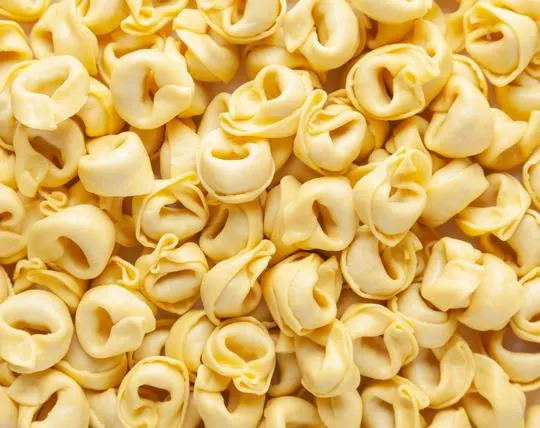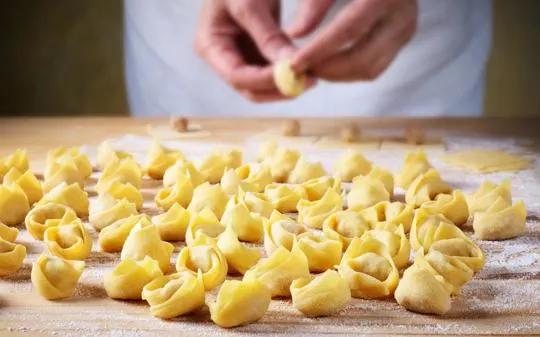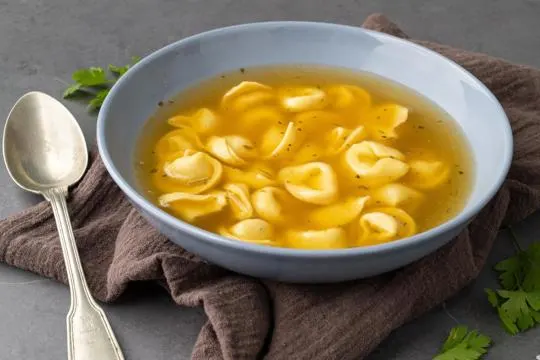Summary of key points
The main difference between cappelletti and tortellini is the shape and filling. Cappelletti, also known as “little hats,” are small pasta pockets filled with a mixture of meat, cheese, and vegetables. Tortellini, on the other hand, has a distinct ring shape and can be filled with various types of cheese or meat.
This distinction also affects the texture and flavor of these two types of pasta. Cappelletti has a thicker and chewier texture compared to the delicate and thinner tortellini. In terms of taste, cappelletti tends to have a richer and heartier flavor due to its filling, while tortellini’s taste depends on the type of filling used.
In cooking, both types of pasta are often used in soups or as a standalone dish with a sauce. However, cappelletti can also be baked and served in a casserole.
In terms of nutrition, both options offer similar health benefits and can be part of a balanced diet when consumed in moderation. It’s essential to pay attention to serving sizes and ingredients when choosing between cappelletti and tortellini.
In the great pasta debate, two stars often get mixed up. Cappelletti and tortellini.
We’ve all been there, standing in the pasta aisle, puzzled.
First off, they might look like distant cousins at a family reunion. Yet, these pasta types have their own stories. We found ourselves arguing over dinner once about which was which. It’s easy to do.
Cappelletti, hailing from the north, often swims in broth. It’s a holiday treat for many. On the flip side, tortellini, packed with meat or cheese, calls Bologna home. A plateful screams comfort food.
Our great “pasta-off” left us laughing and a tad wiser. Here’s to hoping this clears up the confusion for us all.
What are Cappelletti?

Cappelletti are a type of Italian pasta, shaped like tiny hats.
They are stuffed with meat, cheese, or veggies, then folded into their unique shape.
These little pockets of goodness have been popular for centuries in Emilia-Romagna.
The name “cappelletti” translates to “little hats” in Italian.
Every one is made by hand with skill and precision.
What sets cappelletti apart is their shape.
Tortellini are similar, but have a rounder shape with edges twisted together.
Cappelletti have folded corners, resembling miniature hats.
The fillings vary, from meats combined with herbs and spices, to vegetarian options like ricotta or spinach.
Cappelletti can be cooked and served in many ways.
Boiled in broth, they make a comforting soup.
Or, when cooked in a sauce, they become an elegant main course.
What are Tortellini?

Tortellini, a delightful Italian pasta, is known for its unique shape and delicious taste.
These small ring-shaped parcels are usually made from a rich flour and egg dough.
Filled with a flavorful mix of meat, cheese, or vegetables, they originate from Emilia-Romagna in Northern Italy.
Legend has it that the shape was inspired by Venus’ navel.
Skill and precision are needed when preparing the dough to form the small rings.
Tortellini is highly versatile.
It can be boiled and served with a savory sauce or broth, pan-fried for a crispy texture, or baked in a gratin with cheese and cream.
This allows for endless culinary creativity.
It’s no surprise that tortellini is popular worldwide.
From classic recipes like tortellini en brodo, to more adventurous combinations like spinach and ricotta filling – there’s something to suit every palate.
Differences Between Cappelletti and Tortellini

Cappelletti and Tortellini, both Italian pasta dishes, look alike. But they differ.
Origin and Regional Variations
Cappelletti and tortellini – two distinct yet equally delicious pasta dishes. Each from a different region of Italy.
Cappelletti come from Emilia-Romagna and take the form of small crescent-shaped pasta with a variety of fillings, such as meat or cheese.
Whereas tortellini originate from Bologna and Modena.
They are ring-shaped pasta crafted with an intricate folding technique to encase fillings like prosciutto or Parmigiano-Reggiano.
Every dish carries the unique flavors and traditions of their regions, showing the art and variety of Italian cuisine.
Ingredients and Filling
Cappelletti and tortellini may look similar, but their ingredients and fillings easily set them apart.
Cappelletti, from Emilia-Romagna in Italy, is made with flour, eggs, Parmesan cheese, and sometimes spinach or nutmeg.
Fillings can be classic meats like prosciutto or ricotta cheese and mushrooms.
Tortellini is from the same Italian region and is made with flour, eggs, and salt.
It is usually filled with pork loin or mortadella, but can also include cheese and vegetables.
Cappelletti is known for its creative fillings.
You can try combinations like ricotta and mushrooms, or prosciutto with aromatic herbs.
The possibilities are endless. Tortellini, on the other hand, is all about its ingredients.
It has a subtle taste of pork loin, Parmesan cheese, and even spinach-infused flavor.
These Italian pastas have been around for centuries.
They appeal to fans with their flavors, shapes, and history.
Cappelletti tantalizes with its flavorful fillings, while tortellini captivates with its simplicity and authentic taste.
People all over the world are in awe of these Italian treasures.
Shape and Size
Cappelletti and tortellini, both popular Italian pasta shapes, differ in shape and size.
Cappelletti looks like a hat, while tortellini is shaped into a ring.
These shapes provide unique culinary experiences.
Cappelletti is larger and has more filling than its dough.
However, tortellini is smaller and offers a balanced ratio of pasta to filling.
This contrast influences the dining experience, allowing people to enjoy the flavors in different ways.
Flavor and Texture
Cappelletti and tortellini have plenty of differences. Cappelletti is delicate with a velvety texture.
Tortellini has a bolder flavor and a firm yet tender chewiness.
Cappelletti’s taste depends on the filling.
Traditional fillings like cheese and meat make it very subtle.
Its smoothness enhances the overall flavor.
Tortellini is filled with savory meats like prosciutto or creamy cheeses like ricotta.
This creates an explosion of flavors with every bite.
The texture makes it satisfyingly chewy. Both can be used in different ways.
Cappelletti goes well with lighter sauces like butter or broth-based.
Tortellini is good with heartier sauces like Alfredo or tomato-based.
Serving Traditions
Cappelletti and tortellini are two Italian pasta dishes with distinct variations in fillings, shapes, and sauces.
Serving traditions for these delicacies vary across different regions of Italy.
In Emilia-Romagna, the native region of cappelletti and tortellini, they are served as a first course for special occasions.
Cappelletti are hand-folded and presented in broth – allowing for flavors to meld.
Tortellini, however, are served in luxurious cream sauces.
These dishes have cultural significance too.
Cappelletti’s shape is said to resemble baby Jesus wrapped in swaddling clothes, while tortellini’s iconic shape is connected to fertility.
So, the next time you savor a plate of cappelletti or tortellini, remember the traditions and stories they tell.
Appreciate the craftsmanship and depth of Italian gastronomy.
Similarities Between Cappelletti and Tortellini

Cappelletti and tortellini may seem alike, but they possess unique features.
Both these Italian pasta kinds have the same trait of being filled with yummy ingredients.
Yet, more than just stuffing, their origins and uses are similar.
Cappelletti and tortellini are both popular pasta types hailing from different parts of Italy.
Cappelletti is from the Emilia-Romagna region, specifically Bologna, while tortellini comes from the neighboring Emilia area.
These places are famed for their culinary culture, making cappelletti and tortellini treasured dishes.
Although they are both filled pastas, they differ in shape.
Cappelletti looks like little hats or bonnets with pleated edges.
Tortellini, on the other hand, takes on a ring shape.
This difference in shape influences how each pasta holds its fillings.
An additional variation between cappelletti and tortellini lies in their traditional preparations.
Cappelletti usually forms part of a soup called “tortellinata” or “cappelletty en brodo,” where the delicate pasta floats in a tasty broth.
On the contrary, tortellini is commonly served with cream or tomato-based sauces, allowing its unique taste to shine.
Cooking and Serving Suggestions for Cappelletti and Tortellini
Cooking and serving cappelletti and tortellini offer many delicious options.
Boil them and serve in broth or sauce.
Cappelletti is usually in broth while tortellini with pasta sauce.
But, there are other ways to savor each.
Cappelletti’s delicate shape allows it to absorb the flavors of soups.
Perfect for traditional Italian brodo or chicken soup.
Even, salads can benefit from cappelletti’s flavor and texture.
Tortellini’s larger size and firmer texture pairs well with robust pasta sauces.
Options like marinara, bolognese, alfredo or carbonara.
Or, bake with cheese and breadcrumbs for a gooey treat.
Pan-fry for a crispy exterior and tender filling.
A great way to add flavor and texture contrast.
No shortage of creative ways to cook and serve these Italian pasta treasures.
From soups to pasta dishes, explore possibilities.
Enjoy the delicious versatility cappelletti and tortellini bring to the table.
Conclusion
Cappelletti and tortellini are both delightful stuffed Italian pastas that offer a rich range of flavors which is why it can be difficult to determine the difference between them.
As you can see there can be some mild variations in their respective fillings, shapes, sizes, and regional sources.
It is important to note that some regions will have similar, if not identical dishes with minor changes in name according to the local flavor.
Therefore, one should always anticipate and respect the regional variations regarding stuffed pastas.
Although tortellini may be more popular or better known outside of Italy, cappelletti still holds a place of distinction as a traditional pasta filling from certain local areas.
Whichever filled pasta you prefer to make or enjoy eating, research the traditions behind it first before assuming there is only one right answer.
Enjoy exploring these Italian specialties.

Leave a comment